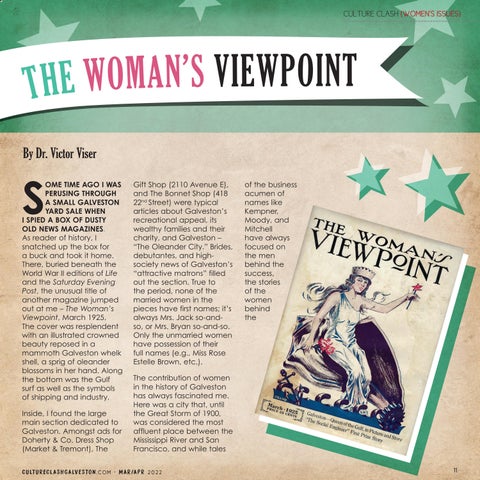CULTURE CLASH (WOMEN’S ISSUES)
T N I O P W E I V S ’ N A M O W E H T By Dr. Victor Viser
S
OME TIME AGO I WAS PERUSING THROUGH A SMALL GALVESTON YARD SALE WHEN I SPIED A BOX OF DUSTY OLD NEWS MAGAZINES. As reader of history, I snatched up the box for a buck and took it home. There, buried beneath the World War II editions of Life and the Saturday Evening Post, the unusual title of another magazine jumped out at me – The Woman’s Viewpoint, March 1925. The cover was resplendent with an illustrated crowned beauty reposed in a mammoth Galveston whelk shell, a sprig of oleander blossoms in her hand. Along the bottom was the Gulf surf as well as the symbols of shipping and industry. Inside, I found the large main section dedicated to Galveston. Amongst ads for Doherty & Co. Dress Shop (Market & Tremont), The
Gift Shop (2110 Avenue E), and The Bonnet Shop (418 22nd Street) were typical articles about Galveston’s recreational appeal, its wealthy families and their charity, and Galveston – “The Oleander City.” Brides, debutantes, and highsociety news of Galveston’s “attractive matrons” filled out the section. True to the period, none of the married women in the pieces have first names; it’s always Mrs. Jack so-andso, or Mrs. Bryan so-and-so. Only the unmarried women have possession of their full names (e.g., Miss Rose Estelle Brown, etc.).
of the business acumen of names like Kempner, Moody, and Mitchell have always focused on the men behind the success, the stories of the women behind the
The contribution of women in the history of Galveston has always fascinated me. Here was a city that, until the Great Storm of 1900, was considered the most affluent place between the Mississippi River and San Francisco, and while tales
C U LTU R EC L A S H G A LV E STO N . C O M • M A R /A P R 2 0 2 2
11










